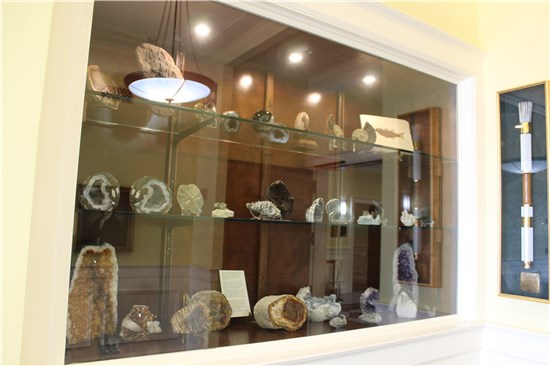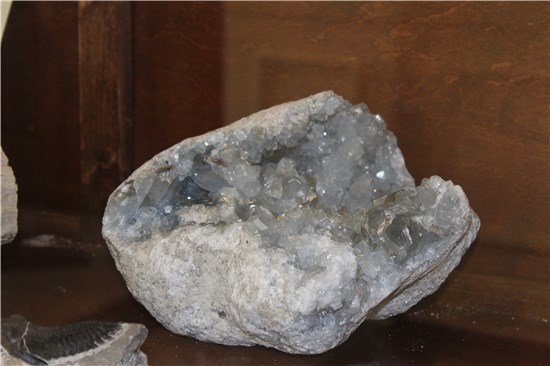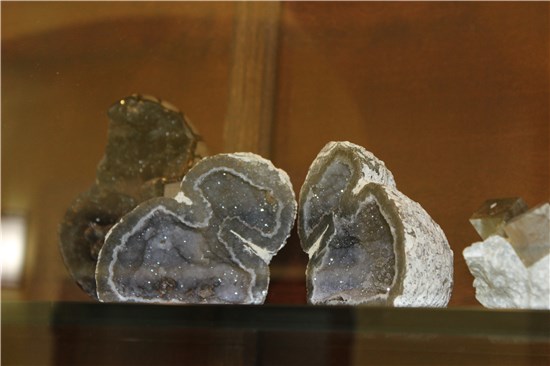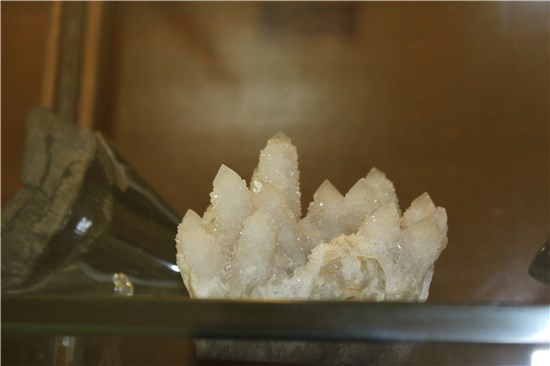Posted on: 03/20/18
 SNELLVILLE – Artifacts dating back millions of years are now on display at City Hall.
SNELLVILLE – Artifacts dating back millions of years are now on display at City Hall.
Owned by Steve and Deedie Golden of Grayson, the collection of fossils and other rare geologic artifacts are located in the display case in the lobby of City Hall, 2342 Oak Road.
They will be on display for six months.
Deedie has been collecting rocks and seashells her entire life and Steve has been collecting for 14 years. Steve cuts, shapes and polishes the specimens while Deedie takes his finished products and creates jewelry and art.
The couple can be found at the Snellville Days Festival May 5 and 6 and the Snellville Fall Festival Oct. 20 at the Pop's Rocks and Pegasus Custom Creations booth.
"We truly enjoy participating in the local festivals where people get to experience minerals and fossils in person, possibly for the first time," Deedie said. "We love sharing the experience and educating people about them."
The Goldens also take their collection to area schools to share with students.
"We are honored to have been invited by the City of Snellville to display our collection in the City Hall foyer for the next six months," Deedie said. "We hope that this collection brings as much joy and fascination to you as it does to us. These specimens come from all over the world and represent millions of years of earth's history. We hope you enjoy our collection."

Inside the Display Case
Top shelf – from left to right
Petrified Wood Slice - Petrified Wood is a type of a fossil where all the organic materials have been replaced with minerals while retaining the original structure of the wood. These minerals are most often Silicates such as Quartz. The many minerals that are washed through the wood over time gives the petrified wood its many colors. Structures such as tree rings and the various tissues are often observed features. Although Petrified Wood can be found worldwide, it is rather rare in larger quantities and can be difficult to obtain museum quality pieces by the average collector.
Crinoid - Crinoids, also known as sea lilies or feather stars, are marine animals that belong to a class of Echinoderms. They lived in both shallow and deep water. They are characterized by a mouth on the top surface that is surrounded by feeding arms. They usually have a stem used to attach themselves to a substrate. There are only a few hundred known modern forms, but they were much more numerous both in species and numbers in the past. Some thick Limestone beds dating to the mid- to late-Paleozoic are entirely made up of their fragments.
Ammonite - Ammonites are perhaps the most widely known fossil, possessing a typically ribbed spiral-form shell. These creatures lived in the seas approximately 300 million years ago. Ammonites belong to a group of predators known as cephalopods, which includes their living relatives the octopus, squid, cuttlefish and nautilus. They ranged in size from less than an inch to about 9 feet in diameter. These specimens come from Canada.
Amethyst Geode - "Mexican Coconut" geodes are mined at The La Choyas Mine in Chihuahua, Mexico. These geodes were formed in a hollow space left by gas bubbles in a cooling lava flow, approximately 44 million years ago. This allowed minerals to line the interior and crystals to grow as groundwater flowed through it. Sometimes agate forms inside, other times it can be any number of iron-oxides, silicates, or calcites. These geodes are mined from clay about 200 feet below the surface of the earth.
Sphere - This sphere is a black agate with a quartz inclusion. Agates are extremely common and found worldwide.
Shiva Lingam - Shiva Lingam Stones are only found in the Narmada River high in the mountains of Mandhata, India and are considered to be sacred. The stones are "Crypto Crystalline Quartz", and are said to contain the loftiest vibration of all stones on Earth. The stone represents both the male energy of knowledge and the female energy of wisdom. No two stones are alike. Think "Indiana Jones and the Temple of Doom" - these are the sacred stones that he rescued and return to their village.
Ammonite pair - Ammonites are perhaps the most widely known fossil, possessing a typically ribbed spiral-form shell. These creatures lived in the seas approximately 300 million years ago. Ammonites belong to a group of predators known as cephalopods, which includes their living relatives the octopus, squid, cuttlefish and nautilus. They ranged in size from less than an inch to about 9 feet in diameter. These specimens come from Canada. This specimen has been cut open and polished to reveal the beautiful interior structure.
Fish Fossil - This fish fossil is a Mioplosus Lapracoides, a true perch. It was collected in the Green River formation in Southwestern Wyoming. Fossils from this location are approximately 40 - 60 million years old.
Middle shelf – from left to right
Eagle Geode - "Mexican Coconut" geodes are mined at The La Choyas Mine in Chihuahua, Mexico. These geodes were formed in a hollow space left by gas bubbles in a cooling lava flow, approximately 44 million years ago. This allowed minerals to line the interior and crystals to grow as groundwater flowed through it. Sometimes agate forms inside, other times it can be any number of iron-oxides, silicates, or calcites. These geodes are mined from clay about 200 feet below the surface of the earth. When this geode was cut open it revealed the eagle like formation, this was a once in a lifetime chance, had it been turned any other way when cut the eagle would have been lost.
Pyrite Sun, Pyrite Cubes and Pyrite with Clear Quartz - Pyrite, or Iron Pyrite, is an Iron sulfide with many forms - such as these cubes and the flat disk. It is brittle and can break or powder easily. Its metallic luster and brassy yellow hue have earned it the nickname of "fool's gold" due to many miners mistaken it for the real thing. Ironically, small quantities of actual gold are sometimes found in Pyrite. It is the most common of the sulfide minerals and is usually found with other sulfides or oxides in Quartz veins, sedimentary or metamorphic rocks. It is found worldwide. Quartz is the second most common mineral in the Earth's continental crust. It is mainly composed of Silica or Silica based minerals.
Septarian - Septarians were formed during the Cretaceous period, 50 to 70 million years ago when the Gulf of Mexico reached what is now Southern Utah. Decomposing sea life killed by volcanic eruptions, had a chemical attraction for the sediment around them, forming mud balls and as the ocean receded, the balls were left to dry and crack. As decomposed calcite from the shells was carried down into the cracks in the mud balls, calcite crystals formed. A thin wall of calcite was transformed into aragonite separating the bentonite heavy clay exteriors from the calcite centers.
Double Geode - "Mexican Coconut" geodes are mined at The La Choyas Mine in Chihuahua, Mexico. These geodes were formed in a hollow space left by gas bubbles in a cooling lava flow, approximately 44 million years ago. This allowed minerals to line the interior and crystals to grow as groundwater flowed through it. Sometimes agate forms inside, other times it can be any number of iron-oxides, silicates, or calcites. These geodes are mined from clay about 200 feet below the surface of the earth.
Pyrite Cubes - Pyrite, or Iron Pyrite, is an Iron sulfide with many forms - such as these cubes and the flat disk. It is brittle and can break or powder easily. Its metallic luster and brassy yellow hue have earned it the nickname of "fool's gold" due to many miners mistaken it for the real thing. Ironically, small quantities of actual gold are sometimes found in Pyrite. It is the most common of the sulfide minerals and is usually found with other sulfides or oxides in Quartz veins, sedimentary or metamorphic rocks. It is found worldwide.
Megladon Tooth - This tooth is from the largest shark ever known to live. The Carcharocles Megalodon sometimes ranged in size up to 60-feet in length and weighed more than 52 tons. This huge monster is the largest predatory fish that ever lived, second only in size to the sperm whale. Fossil teeth have been found that exceed 7 inches in length. These sharks lived in the Miocene period some 23 million years ago to the Mid Pliocene times, 3.6 million years ago. This specimen is from South Carolina.
Fairy Quartz Plate - Fairy Quartz also called cactus quartz, barnacle quartz, pineapple quartz or porcupine quartz. It was discovered around the year 2001, and is only found in South Africa, in the Magaliesberg Mountain region. It consists of a single crystal that terminates in a faceted point and is surrounded by hundreds of similarly shaped but smaller crystals.
Megladon Tooth – This tooth is from the largest shark ever known to live. The Carcharocles Megalodon sometimes ranged in size up to 60' in length and weighed over 52 tons. This huge monster is the largest predatory fish that ever lived, second only in size to the sperm whale. Fossil teeth have been found that exceed 7 inches in length. These sharks lived in the Miocene period some 23 million years ago to the Mid Pliocene times, 3.6 million years ago. This specimen is from South Carolina.
Bottom shelf – from left to right
Citrine Cathedral - Citrine is any Quartz Crystal or cluster that is yellow to brown in color. Fine, clear specimens are used for faceting and ornamental stones.
Smokey Quartz Plate - Quartz is the second most common mineral in the Earth's continental crust. It is mainly composed of Silica or Silica based minerals.
Citrine Plate - Citrine is any Quartz Crystal or cluster that is yellow to brown in color. Fine, clear specimens are used for faceting and ornamental stones.
Wooly Mammoth Tooth - This tooth is from Sibera and is approximately 1 million years old. It shows the external chewing surface of the tooth.
Petrified Wood Stump - Petrified Wood is a type of a fossil where all the organic materials have been replaced with minerals while retaining the original structure of the wood. These minerals are most often Silicates such as Quartz. The many minerals that are washed through the wood over time gives the petrified wood its many colors. Structures such as tree rings and the various tissues are often observed features. Although Petrified Wood can be found worldwide, it is rather rare in larger quantities and can be difficult to obtain museum quality pieces by the average collector.
Trilobite - Trilobites are hard-shelled, segmented members of Arthropoda and the class Trilobita that existed throughout almost all of the Paleozoic era, flourishing in the earlier part of it and slowly declining in the later part. The most common trilobites were about 2-7 cm (1-3.5 in) in length, but over their long history they ranged in size from 1 mm-72 cm (.04 in-28 in). The smallest species are presumed to have been part of the free floating plankton, while the more common, mid-sized species probably walked along the sea floor filtering mud to obtain food, and the larger varieties may have been swimming predators.
Blue Calcite - Calcite is a very common mineral that is found worldwide. This specimen is a blue calcite geode.
Trilobite - Trilobites are hard-shelled, segmented members of Arthropoda and the class Trilobita that existed throughout almost all of the Paleozoic era, flourishing in the earlier part of it and slowly declining in the later part. The most common trilobites were about 2-7 cm (1-3.5 in) in length, but over their long history they ranged in size from 1 mm-72 cm (.04 in-28 in). The smallest species are presumed to have been part of the free floating plankton, while the more common, mid-sized species probably walked along the sea floor filtering mud to obtain food, and the larger varieties may have been swimming predators.
Amethyst Plate - Amethyst is a purple variety of Quartz that is found in large geodes that occur in veins underground. It is found all over the Earth, with the best varieties coming from Brazil and Uruguay. It occurs in color from a light, slightly pinkish violet to a deep grape purple. It has been used throughout time as a symbol of royalty.
Clear Quartz Plate - Quartz is the second most common mineral in the Earth's continental crust. It is mainly composed of Silica or Silica based minerals.
Amethyst Cathedral - Amethyst is a purple variety of Quartz that is found in large geodes that occur in veins underground. It is found all over the Earth, with the best varieties coming from Brazil and Uruguay. It occurs in color from a light, slightly pinkish violet to a deep grape purple. It has been used throughout time as a symbol of royalty.
Fairy Quartz Plate - Fairy Quartz also called cactus quartz, barnacle quartz, pineapple quartz or porcupine quartz. It was discovered around the year 2001, and is only found in South Africa, in the Magaliesberg Mountain region. It consists of a single crystal that terminates in a faceted point and is surrounded by hundreds of similarly shaped but smaller crystals.


